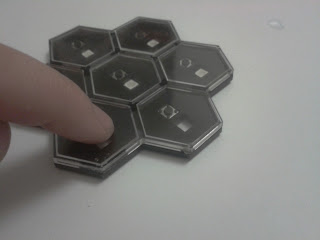(this is the base layer - with holes for the buttons and LEDs to be mounted from underneath)
(this top layer will be cut from clear acrylic and the outer part glued to the base)
Instead of placing our hexes exactly side-by-side, we're cutting them out, leaving a surrounding bit of plastic. Although this is make from clear acrylic at the minute, once assembled, we'll be painting the whole base a single, solid (black) colour. Doing it this way not only saves acrylic, but also ensures that the hex pieces will fit back "inside" the honeycomb surround!
While Steve will probably go ape about us using superglue instead of contact adhesive or some polystyrene cement, we just wanted to see what it would look like so grabbed the first glue that came to hand!
The hexes give a satisfying faint click as each one is pressed. Nothing distracting, barely audible, but enough for you to register that the button has actually pressed down.
The solder tags on the buttons are all on the back of the board now, so there's no need to worry about ugly wires getting in the way (they can just be taped to the back of the board, then the whole thing mounted on a nice base).
At the minute, the hexes are just "floating" inside the honeycomb frame. Tip the board and they all just fall out! Steve suggested using buttons with a taller head on them and putting a few dots of funky foam under each one. By using dots instead of a continuous shape, the hexes can easily be pressed down - and they give an interesting effect to the board: each playing square would now be raised above the rest of the board
We could glue the hexes to the foam and have the foam stuck to the base so none of the squares come loose when the board is picked up and moved around. The only thing is we'd have to change the way we were planning on lighting up the playing squares:
Originally we planned on covering one side of the clear acrylic with a sticker, and using the laser cutter to take out a thin border around the edge of each playing square. But putting bits of funky foam in three of the six "corners" means we'll have to change our engraving pattern - otherwise the foam will get in the way of the light when a square is supposed to be lit up.
The effect isn't quite what we first planned, but is still a reasonable finish. With the correct colour scheme and sticker effect (they don't have to be plain black, they could be textured or slightly hologram-effect) these might actually look pretty cool!








No comments:
Post a Comment